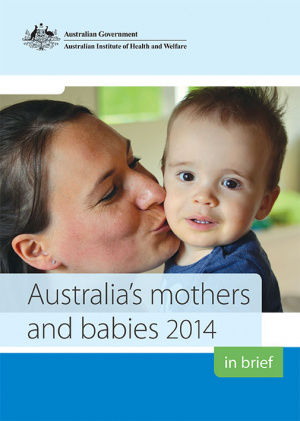Australia’s mothers and babies 2014
| Embryology - 27 Apr 2024 |
|---|
| Google Translate - select your language from the list shown below (this will open a new external page) |
|
العربية | català | 中文 | 中國傳統的 | français | Deutsche | עִברִית | हिंदी | bahasa Indonesia | italiano | 日本語 | 한국어 | မြန်မာ | Pilipino | Polskie | português | ਪੰਜਾਬੀ ਦੇ | Română | русский | Español | Swahili | Svensk | ไทย | Türkçe | اردو | ייִדיש | Tiếng Việt These external translations are automated and may not be accurate. (More? About Translations) |
Introduction
This data summarised below is provided to help you as a clinician or researcher understand the current trends in reproductive medicine within Australia.
The information is based upon data from the publication "Australia's mothers and babies 2014 - in brief"[1]
| Australia’s mothers and babies: 2017 | 2016 | 2015 | 2014 | 2013 | 2012 | 2011 | 2010 | 2009 | 2008 | 2007 | National Perinatal Statistics Unit | AIHW | Australian Statistics | birth |
Mothers
- In 2014, 307,844 women gave birth in Australia—an increase of 18% since 2004 (252,871)
- The rate of women giving birth increased from 59 per 1,000 women of reproductive age (15–44 years) in 2004 to 63 per 1,000 in 2014.
- The average age of all women who gave birth continues to rise and was 30.2 in 2014,
- The proportion of mothers aged 35 and over has increased from 20% in 2004 to 22% in 2014.
- The proportion of mothers aged under 25 has decreased from 19% to 16%.
- 98% (300,282) of women gave birth in hospitals,
- 205,927 of women (67%) had a vaginal birth and 101,896 (33%) had a caesarean section.
Maternal Conditions
- One in 9 women (33,280 or 11%) who gave birth in 2014 smoked at some time during their pregnancy, a decrease from 15% in 2009.
- 8 per 1,000 mothers had chronic hypertension and 34 per 1,000 had gestational hypertension;
- 10 per 1,000 had pre‐existing diabetes and 83 per 1,000 had gestational diabetes.
Babies
- 312,548 babies born in 2014—an increase of 18% since 2004.
- 310,330 were live births and 2,200 were stillbirths (less than 1%) (birth status is not recorded for a small number of births).
- stillbirth rate of 7 deaths per 1,000.
- Slightly more babies were male (51%) than female (49%). The sex ratio was 105.5.
- 1 in 19 babies (5.3% or 16,572) were Indigenous in 2014 (based on Indigenous status of the baby).
- average gestational age for all babies was 38.6 weeks, with the vast majority (91%) born at term (37–41 weeks).
- Pre‐term birth (before 37 completed weeks’ gestation) is associated with a higher risk of adverse neonatal outcomes.
References
- ↑ AIHW 2016. Australia's mothers and babies 2014—in brief. Perinatal statistics series no. 32. Cat. no. PER 87. Canberra: AIHW.
Glossary Links
- Glossary: A | B | C | D | E | F | G | H | I | J | K | L | M | N | O | P | Q | R | S | T | U | V | W | X | Y | Z | Numbers | Symbols | Term Link
Cite this page: Hill, M.A. (2024, April 27) Embryology Australia’s mothers and babies 2014. Retrieved from https://embryology.med.unsw.edu.au/embryology/index.php/Australia%E2%80%99s_mothers_and_babies_2014
- © Dr Mark Hill 2024, UNSW Embryology ISBN: 978 0 7334 2609 4 - UNSW CRICOS Provider Code No. 00098G
